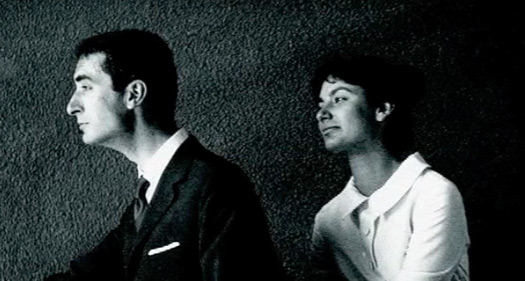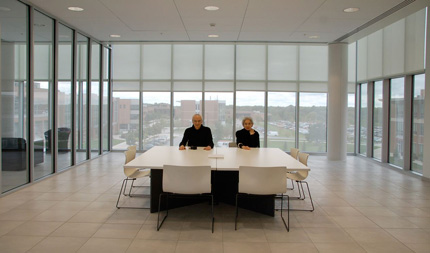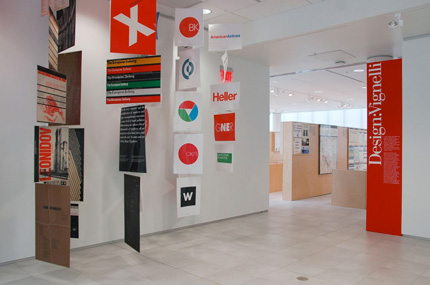
Lella and Massimo, circa 1957
He is an extrovert. Gregarious, outspoken, delighted to work the crowd that is usually equally delighted to be in the room with him. She is poised, quieter, more reserved, less comfortable with the spotlight though no less deserving of its shine. Together they are confident in their choices, earnest in their vision, and determined to create something lasting in a profession that is too often ephemeral.
Lella and Massimo Vignelli. It is intriguing to think that with a lifetime of effective design solutions, diverse clients, international recognition and professional visibility, the Vignellis are hitting their stride with perhaps their most important work of all. We could say that the Vignellis have now become their own client as they are documenting their wealth of experiences, connections, thoughts and pathways. They are branding it with a building as the Vignelli Center for Design Studies at RIT, setting it typographically in the Vignelli Canon, living it in Roberto Guerra’s documentary Design is One — The Vignellis. Massimo always talks about the search for meaning and the search for understanding, culminating in the search for the way to convey this to others; now we can see and experience how they do this for themselves.
Their work — publications and packaging, furniture and products, showrooms and architectural interiors, identity programs and transportation graphics, and more — has been well-documented. The tangible artifacts, interesting as they may be, offer only a snippet of a larger story. Instead, looking at the Vignellis career trajectory illuminates meaningful realities in design practice. The Vignellis have been where many designers would like to be. A few times they’ve stumbled, more often they have been dramatically successful. There is much for students to learn and their focus now is on the students, on the learning, and on the future.
Challenge and Stimulation
The Vignellis have always worked as a team. As a young couple continuing their studies and setting foundations for their lives and careers, they faced timeless questions: What have I learned? What are my capabilities? What challenges are big enough? Are there any that are too big?
They established a successful office in Milan, living a life that balanced work and play in a country that they loved, but they gave it up when Massimo became a founder of Unimark International in 1965. They were twentieth-century immigrants, arriving on the dock with furniture, suitcases and trunks, just like previous generations. The fear of the unknown scares people even if the move is simply to a job around the corner. How many of us would make an international leap, tackling language and cultural differences?
“You can leave Milano very easily when you are coming to New York; it was an easy trade,” said Massimo. “We were very successful in Milan and we kept bouncing our head against the ceiling. After awhile there was no more stimulation in being at the top. We were looking for a higher ceiling. It can be hard…. The first two years you feel homesick. You have no friends, you are in a new place, even the food is different.”
Balance and Perseverance
How do I blend my personal and professional life? How do I balance family and work responsibilities? How do I believe in myself when others are doubting? How do I progress when obstacles are placed in my path? Are the answers different if I am a woman?
“When we first came over [to the United States] in September of 1957, we were still on honeymoon and we’ve been that way for many years,” said Massimo. Like most young couples, they sought independence, breaking away from their families to define themselves as individuals and as a couple. “The greatest part of our work has been growing together,” Lella said. “You must have the same sort of preferences. This is good with us, we are complimentary, we balance. In a relationship, it is important that you don’t let yourself be taken over. We do our own projects but we listen to each other.” She laughed. “I am practical, Massimo is creative but he is disorganized.” “Lella is my brake, my reality, I could not have done this without her,” said Massimo. He laughed too.
Sometimes their partnership was tested, notably when married couples were once discouraged — and often forbidden — to work together in American offices. Unimark too had an official policy against working couples. It was only partially applied for the Vignellis but there was still disparity: Lella’s work was contractual while Massimo held a very public role as a founder and Design Director. Lella might have been responsible for a project but her presence was somewhat suspect to construction workers on project sites. A mix of exasperation and bitterness is still apparent as she recalls those times. “‘Oh Sweetie, what are you doing, hanging around? We have questions, send your husband,’ they’d say. I was critical when their work was sloppy and they resented that,” she said. In that era, it was harder for a woman to gain respect and cooperation, simply because she was a woman.
Balancing professional goals and a job with the demands of home and family often was, and is, complicated for women. Men are not immune to these issues, but typically women bear the brunt of work and worry for the family. Lella was no exception as she mothered their two young children, managed the household, kept a watchful eye on business records, and still maintained her own career. “It wasn’t that easy,” she said, “I wanted to focus on my work, but I couldn’t totally. Many times I didn’t trust myself; I was tired, I couldn’t think straight.” Lella worries as their daughter, and other young women, face many of the same concerns.
Looking at Lella’s accomplishments proves that perseverance pays off. “Now is the best time of my life,” she said a few years ago. “I am doing the showrooms; they please me. I am traveling — I have less responsibilities with home, with cooking, with record-keeping. I am in control of myself. Being older helps too.”
The Vignellis often interrupt each other as they finish one another’s sentences or elaborate on a thought. It bothers them both, and it is something they continue to work on, but the habits of a lifetime are hard to break. On the plus side, it is a sign of their constant sharing of information. Their big ideas are developed together, and they are fully understood by both partners.
Standards, Superficiality and Recognition
Is it better to be safe or should I take a risk with something new? Should I strike out on my own or continue working for others? What sort of work do I want to do? What compromises am I willing to make? Is there a design imperative I must follow?
In 1971, Massimo left Unimark and Vignelli Associates was opened in New York. The Vignellis were happy to again operate as partners and the experiences with Unimark framed their business. “No middle managers, no focus groups!” said Massimo. “Not so commercial!” said Lella. Even then the equality of their partnership was not always recognized. In early days, work was often a collaborative effort but many publications edited the credits, citing Massimo only. Lella was justifiably angry about this. “I’d go to the office in the morning and look at the mail,” said Massimo. “Any magazine that would show just my name [as designer], I’d make it disappear.” Now they laugh at those memories.
Time solidified their design process and their reputations as the Vignellis maintained a steadfast insistence on the validity and value of their approach. “We work through a process; it is the backbone of our methodology,” said Massimo. They have openly criticized others deemed less thorough or thoughtful. “There is a process of thinking: examining, sifting, digging, exploring until you get down to the thing that is just right. Sometimes I discover by happenstance, but a lot of people get seduced by happenstance and that is a very different thing. That is the culture of the found object as opposed to the culture of the designed object. It is not that it is a wrong way of working, it is a different way of working.”
Massimo made the previous statement in 2006. In 1993, he challenged a leading American designer saying, “I see your sense of cultural responsibility being taken over by your desire to be different at any cost… In our culture and society, typographical refinement and design responsibility still have a long way to go. I know your intent is more noble than it looks and I respect it, but the form it takes is highly irresponsible since it breeds shallowness in the name of newness.”
Vignelli tirades against sloppiness, against superficiality, against post-modernism, became legendary. In 1992, Massimo blasted Emigre as “A national calamity. An aberration of culture,” though just a few years later he enthusiastically collaborated with Licko and VanderLans. Massimo didn’t always rant and he could often be poetic in expressing the mood of the day. In 1982 for U/lc, he eloquently summed up three decades of design: “If the Sixties stressed the concept of discipline, and the Seventies that of appropriateness, the Eighties were finally intrigued by the pleasures of ambiguity.”
Have they mellowed over time? Lella speaks of their obsession with perfection and the importance of building from an intellectual platform. That has not changed. They are passionate in their commitment to design and consistent in their condemnation of trivial styling and planned obsolescence. The potential for explosiveness remains toward those whose attitudes and applications are deemed less respectful. It doesn’t take much time with either of them to see this, as noted by a student in the 2010 Dialogues in Design workshop: “Massimo can get aggressive with someone who does bad work, but his profession is his life, so it makes perfect sense if he reacts to protect it. He doesn’t compromise.”
Time Marches On
How do I cope with change? With loss? What will be my legacy? What have I learned and how can I share it with others?
Speak with the Vignellis about good people, and they’ll recite a long list of great designers, sensitive typographers, fine project managers who came through their offices. Good people often have other opportunities and their leaving is difficult but that too is a part of the business of design. Sometimes the leaving was traumatic, especially given Massimo’s emotional expressiveness, but eventually all was forgiven and warm relationships continued. “So many grew up in our office,” said Massimo. “I am happy to hear the positive mentions of their time with us and its formative effect on their careers.”
In 2000, the lease expired on their Manhattan office space. The resulting downsizing set people free as Vignellis then intertwined their personal and professional lives even closer by moving their office into their home. In the years since there have been many experiences, good and bad. There were losses, particularly David Law, who passed away in 2003. “David was a tremendous loss,” said Massimo. “Like Lella, he was my partner and of all the people we worked with, I was closest to him. We drew the same; I could not distinguish between our drawings and I’d have to ask him, did I draw that, or did you? Finally I had to put a mark on my work so I could tell.” There have inevitably been some changes for both of them in recent years and they’ll admit to slowing down a bit (maybe), but together the Vignellis seem to be unstoppable. They are the Energizer Bunnies of the design world.

Lella and Massimo Vignelli, Vignelli Center for Design Studies at RIT, September 2010
So we reach September 2010, and dedication ceremonies for the Vignelli Center for Design Studies at RIT in Rochester, New York. The Vignelli archives will reside alongside those of design pioneers Will Burtin, Alvin Lustig, Lester Beall, Cipe Pineles, William Golden, and many others. To understand the progression of American design, “you need time, you need perspective,” said Massimo. “The only time you get the proper perspective is after seeing both the impact [of your work] and historically what role it played. The archives — where students can see the whole thing — there is nothing comparable, no slide that can compare to the real thing. It is not that the slide isn’t great but it is also the context.” The continually expanding archival collections at RIT will be a tremendous resource for students and historians for generations to come.

Vignelli Center for Design Studies at RIT, September 2010

Lella and Massimo Vignelli exhibition, Vignelli Center for Design Studies at RIT, September 2010
The time for tirades has mostly passed to be replaced by the time for teaching. For now the Vignellis are continuing to solve design problems and they are conducting workshops, critiques and lectures around the world. A print version of the Vignelli Canon will be released this month by Lars Müller Publishers. “Creativity needs the support of knowledge to be able to perform at its best,” it says in the Introduction, and now Massimo and Lella are sharing their knowledge with all of us.
The Vignellis are excited, proud, and as the dates of the dedication ceremonies approach, they are just a bit emotionally overwhelmed by the significance of this event in Rochester. No matter what individual design approaches we might follow, the rest of us should be inspired by their lead.
